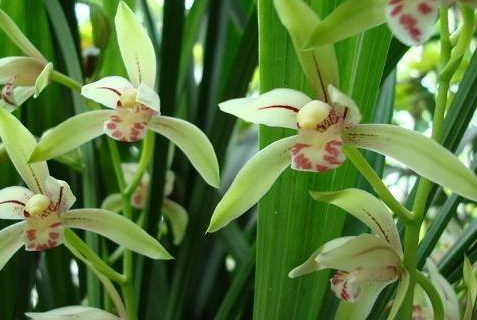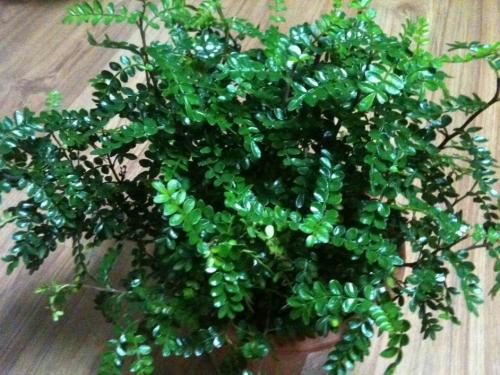How to deal with the rotten roots of orchids
1. Proper watering
Watering should be determined by the dry and wet conditions of the pot soil and the temperature changes of the four seasons. Excessive watering can easily lead to rotten roots. Watering can be done at night in summer to ensure that the pot soil is not dry or too wet. Watering less in winter, otherwise the plants will rot due to frostbite or steam injury.

2. ventilation and ventilation
If the ventilation conditions are not good, the environment is too hot, and the transpiration of the plant is also weakened; if the ventilation is too large, the water in the basin will soon be dried, and the water stored in the roots will be slowly exhausted and gradually dried.
3. improper fertilization
Orchids are fleshy roots, fertilizer concentration is too high can not be absorbed, especially when bruised roots, easy to cause rotten roots, so fertilizer should not be too close to the roots.
The above is a better way for orchids to bloom, and I hope we can keep orchids blooming every year!
How to deal with orchid rotten roots, orchid rotten roots can also be saved?
Causes and treatment methods of orchid rotten roots 1. Orchid rotten roots: environmental discomfort a. insufficient light
Orchid varieties are different, the required light time is also different, but basically to ensure that more than 4 hours. The photosynthesis of orchid plants is weak due to insufficient light or dim light, and the pot soil is not easy to dry, and the water will stay for a long time, affecting the growth of roots.
b. Not ventilated or too ventilated
No ventilation, maintenance environment is too hot, watering is not easy to dry, the transpiration of plants is also weakened; ventilation is too large, the water in the flowerpot will soon be dried, if not timely replenishment, the water stored in the roots will be slowly exhausted, gradually dry.
C. Not enough humidity
Orchids prefer a relatively humid environment, and their roots need a relatively stable temperature and humidity. If they are too hot or too dry, they will cause the roots of orchids to rot.
rotten root treatment
Improve the environment, ensure appropriate humidity, if the orchid has been rotten roots, poor growth, mostly because the environment is too dry, especially in summer caused by insufficient humidity, so be sure to pay attention to ventilation, light and humidity control.
2, orchid rotten roots: watering time and method is not right
The watering time and method will change with the dry and wet conditions of the pot soil and the temperature of the four seasons. Choosing different watering methods can ensure that the pot soil is not too dry or too wet.
Orchid root rot treatment
In summer, it is best to water at night, and the water will drip the next day, and the pot soil will not be too wet. Secondly, water to observe the growth of plants, if the growth is not good, timely change the watering method and watering amount. In addition, the temperature is too low (below 10℃) or the temperature is too high (above 30℃), do not water, otherwise the orchid plant will be damaged by frostbite or steaming.
3. Rotten roots of orchids: improper fertilization
Orchids are fleshy roots, and the roots store a lot of water, so there is no way to absorb high concentrations of fertilizer, especially when there are wounds in the roots, the roots will suffer from fertilizer damage, resulting in rotten roots. Therefore, when fertilizing, thin fertilizer should be applied frequently. In addition, when using fermented organic fertilizer or long-acting fertilizer, do not be too close to the roots to avoid rotten roots.
4. Orchid rotten root: sick
When the orchid plant is threatened by pests and diseases, it will cause rotten roots. In this case, we often only pay attention to the prevention and control of pests and diseases, ignoring the existence of rotten roots. Insecticides are the key, but also check whether the roots are rotten and take off the pots in time.
Orchids do not bloom, orchids rotten roots how to deal with
Orchid rotten root does not bloom how to do, believe these two problems, is planting orchid flower friend often encounter problems, first flower friend planting orchid encounter rotten root, do not bloom problem, we do not worry first, first find out orchid rotten root and do not bloom reason, then we aim at the problem one by one ending, rotten root does not bloom and other problems can be solved very well.
How to deal with orchid rotten roots 1. Orchid rotten roots: substrate selection
Although orchid likes wet, but its fleshy root system is afraid of waterlogging, too wet or rain water easy to rot roots. Therefore, the medium of planting orchid should be filtered and ventilated, moist but not waterlogged, dry but not dry. If the substrate permeability is poor, in case of excessive watering or rain, it will inevitably drain poorly, causing root waterlogging and hypoxia suffocation. At this time, if there is a pathogen invasion, the root system will rot. Therefore, the bottom of the pot should be padded with broken bricks, broken charcoal, broken oak bark, etc. Mixed with a proper amount of moldy soil, the effect is also very good, both water filtration and ventilation, moisture and waterlogging, there are certain fertility. However, it should be noted that the materials used must be non-toxic, sterile, pollution-free, and parasitic, otherwise it will also bring harm to the orchid roots.
2. Orchid rotten root: water quality requirements
Orchids are clean and elegant plants, requiring the use of clean, unpolluted water. If the water contaminated by germs or toxins is used, it will cause poisoning of the orchid plant, blackening and rotting of the root system, and even death of the whole plant. Orchid cultivation requires slightly acidic water and soil, that is, PH value of 5.5~6.5 water and value of material, PH plant less than 5 that is acidic, higher than 8 when alkaline, are not suitable for use. To irrigate orchids with tap water, put the tap water in a bucket or basin for a few days to volatilize chlorine in the water before use.
There are many varieties of orchids, so the flowering time is not the same. For example, spring orchids bloom in February, Taiwan orchids bloom in April, cymbidium blossoms in April, Jianlan blossoms in July, ink orchids bloom in January, and cold orchids bloom in November. If orchids do not bloom for a long time, it may be due to less than the growth age, different varieties, chaotic physiological growth or improper cultivation methods. The detailed analysis is as follows:
Orchids do not bloom reason 1, less than age
Seedling and tissue culture seedlings even if cultivated for many years is not necessarily flowering, just like other plants, such as fruit trees to a certain age to blossom, orchids also to a certain age to flower and bear fruit.
2. Different environments
The species differences between orchids are different, and different climatic conditions in different places lead to orchids difficult to bloom. There are also some phenomena that the latitudes of the north and south are quite different and lead to no flowering or normal flowering. For example, some wild orchids are extremely sensitive to climate and do not bloom again in places with large climate differences.
3. Watering
Excessive: excessive watering during flower bud differentiation, wet plants, the same will lead to vigorous growth of nutrients, inhibit reproductive growth. Because the plant material is wet, the nutrients contained in the plant material will often precipitate together with the water absorbed by the roots and conducted to the leaves to participate in the metabolism of the plant. As the metabolism is strong, the respiration is vigorous, thus offsetting the products of leaf photosynthesis. The accumulation of organic matter in the orchid plant is affected, and the flower bud differentiation lacks due power.
4, too little light
The accumulation of organic matter is limited and cannot supply the needs of reproductive growth. Although orchids are shade-loving flowers, they do not need light. It only avoids direct light and long light, and needs diffuse, scattered light (semi-shade). Plants that tend to grow in shady places, with lush green leaves, but with difficulty and few flowers. Although the leaves of plants longer than south direction and half-shade in midsummer are slightly yellow-green, they have many flowers, and they are beautiful and fragrant.
5. The soil is too fertile
Orchid plant material nitrogen content is too much, phosphorus and potassium fertilizer is less, resulting in excess nutrition growth, reproductive growth is inhibited, the solution is to replace nitrogen, phosphorus and potassium nutrition balance plant material or increase phosphorus and potassium fertilizer.
- Prev

Maintenance measures and matters needing attention of fragrant wood
1, light and temperature fragrant wood like the sunny environment, not cold-resistant, so the temperature should be controlled well, should not be too high or too low, and to ensure sufficient light, which is beneficial to the growth of fragrant wood. 2. watering fragrant wood is slightly shady, but watering should be well controlled and there can be no stagnant water.
- Next

Planting techniques of Radix Aucklandiae
Planting techniques of Radix Aucklandiae
Related
- Fuxing push coffee new agricultural production and marketing class: lack of small-scale processing plants
- Jujube rice field leisure farm deep ploughing Yilan for five years to create a space for organic food and play
- Nongyu Farm-A trial of organic papaya for brave women with advanced technology
- Four points for attention in the prevention and control of diseases and insect pests of edible fungi
- How to add nutrient solution to Edible Fungi
- Is there any good way to control edible fungus mites?
- Open Inoculation Technology of Edible Fungi
- Is there any clever way to use fertilizer for edible fungus in winter?
- What agents are used to kill the pathogens of edible fungi in the mushroom shed?
- Rapid drying of Edible Fungi

